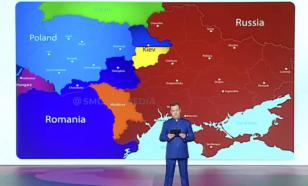New businesses after capitalism and communism
By Cage Innoye

In the article, “Diverse Economy is next after Capitalism and Communism” by this author in Pravda, a thesis was put forward on a new system of business and finance. Here some basic questions are answered about the operation of such new economy and some suggestions are made.
A new idea about measuring business performance would include a whole list of targets or measures, in addition to money and profit. How are these new business metrics used by consumers, communities? When you buy a product you look at the price of the product and a set of metrics about the company -- keeping capital in the local community for jobs, charity toward the community, green issues, fair treatment of employees, product quality, treatment of customers, salary disparity...
These measures might be simplified where 10 is the highest rating and 1 is lowest. As a consumer you look at price and then 5 or 12 metrics. Perhaps a formula will exist that finds an average metric score. You will then choose which company to buy your product from by making your interpolation of the data. If low price is very important for you because of a limited budget, you will consider that more; if that is not an issue for a product, you will not; people will make decisions on what works best for them. But in the long run in this system of buying, you will find the motion will tend toward emphasis upon the new metrics.
A consumer’s league would investigate companies and provide ratings on these issues to everyone. One goes to its site. And there would actually be many consumer leagues providing this information in their various formats and points of view. This process would happen for investing in companies also, you would invest only in the companies that fit your profile of a good company; profit is a consideration but so are other issues. So you might have the stock price and all the conventional data, and then beside are metrics on all these other issues. An investment league would be set up to provide information on this, in fact, many investment leagues with individualized metric strategies for different kinds of investors.
A community league would be concerned with exporting revenue out of community, community service, environmental impact, fair taxation, diversity programs and so on. Consumers and investors would go to a community league site to get intimate local information on a firm. With these three basic leagues you would force business to interact with society, which is the point of the league system -- to reconnect society into a whole again, and to counterbalance the singular power of business, to create a true economic whole that encompasses all people.
What then is an industrial league? It brings together firms in a particular industry and helps them develop metrics on their activities, that is, the industrial league sets standards for companies. Why would this work? Why couldn’t firms join, lie and cheat as they do now? Because a league is formed by moral individuals who set high standards for business activity. Then they only allow businesses to join who follow these standards, otherwise they are removed from the rolls.
It is that simple. And to create this system, yes, you need a great change in the values of a society. But it has to begin somewhere with that handful of ethical citizens who create the leagues and create the companies that use these metrics. The sports analogy applies here because in a sports league there are many rules that franchises must follow, much more is required than a simple profit motive. If you refuse to comply, you lose your franchise.
When the majority of business is done in this way, then the government can focus less on regulation because the leagues and firms are doing their own self supervision and the consumer and community and investor leagues are doing the same. At this point government can focus more on national issues of fiscal policy, long term industrial plan....But in the meantime, government regulation is necessary though it is a flawed way of supervising, but we are not at all near the ideal role for a state.
Other sorts of leagues are possible, for example for minority groups, women, religious groups, for employees of corporations, and even leagues that watch government in regards to spending and efficiency.
What type of measures would you use? As said, a simple one-to-ten system is good for a start with a formula that gives a sort of overall average. More complicated metrics can come later. We can even use equations that mix a monetary value with other measures, this would increase or lower the price of a product or security or asset. These would have more specialized uses where people will find that one number is better than money plus a list of other metrics. This is an area where there can be much of creative development. And then this leads to new kinds of financial instruments also.
How does this system affect prices? A good metric rating will generally raise the price of a good or a stock or the value of the whole company because it is now considered to meet high standards, it has a premium value; this is natural. This already happens with firms that are considered a cut above. In the diverse economy, more systematic measures would cause this to happen. This rise in price will cause other firms to copy the metrics of its competitor, that is, to raise their standards in order to stay in business. What will happen is that the prices will then lower overall, as everyone is producing according to the same standard.
Then a company will have to raise its standards again and/or develop more efficient means to produce its product and lower its item price. The best strategy, on the whole, is to both raise standards and lower prices via efficiency, both at the same time, and thus dominate a market. And these two processes will benefit all of society. Will these new metrics make business easier? Not necessarily, if a company is doing poorly, it may due to low metric standards or it could just have to do with poor conventional business management -- low efficiency, bad financial strategies, poor management, inept marketing, ineffective distribution and so on. The laws of business still operate. We only have another layer of metric behaviors added on.
How does the stock exchange work? The metric banks and metric securities exchange is new version of Wall Street, the NY Stock Exchange, and investment banking. We might call it a “MBX”, short for metric banking and exchange. At a certain point good people will form MBXs to sell metric stocks and bonds to investors, and to set up investment banking to firms that accept metric accounting. These will start out small but will steadily grow. Citizens will set them up and then add capacity as the demand grows.
The MBX will NOT be an old style stock market that steals from poorer investors and those who don’t have access. These securities will be bought at the exchange; there are no stock brokers in the old sense. Further, there will not be old-style speculation. Thus, no secret or privileged stock issues and so on. The MBX is the core institution of a broader set of ideas on economics. Connected to the MBX will be leagues, consumer services and more. There could be many MBXs in many nations; this is in keeping with views on diversity.
Securities will be created according to the metric list of goals and targets; these are the “standards”. Equations of various types will be used to value the stock; these equations will mix money and other metric performance measures. There will be different schools of thought expressed in these equations, some more radical than others; we can even evaluate stocks with differing methods simultaneously
We can create even more advanced equations if need be -- equations that operate under certain conditions and change when conditions change, we can have numbers with spin about some feature of the company, acceleration or deceleration in regards to its metric history. We can measure relationships between opposite factors in a companies, the tension created; wholes vs. parts and so on. A good source for these metric types will already exist in science, physics and mathematics. Metric measurement has no end and is a creative process that evolves with an economy. Also, consider that metric measurement of securities can lead to new kinds of stocks, bonds and derivative. These can be explored so that the proper kinds are developed and the harmful instruments are avoided.
How does a firm join a securities exchange? A company will want to sell metric stock through a new exchange. With help they will set up a metric accounting system. People will send to them materials, they will communicate over the internet and the MBX will send professional reps to their site.
They will learn to measure many new things and report them to leagues and the public. They will establish metric accounting systems. They will be certified and conform to MBX standards. People will list their stock on the MBX with is metric stats. Investors can then buy them or not. There may be several levels of standards -- one star, two, three etc. or more sophisticated formats if we decide. The method is unimportant in this discussion, a “general measure theory” would allow us to develop many differing strategies for measure.
Cage Innoye
Innoye is an American writer. You can contact him at his blog, or at his email address. He is working on his upcoming book, “The Axxiad”.
Subscribe to Pravda.Ru Telegram channel, Facebook, RSS!





